| |
CIRRUS Monthly Proficiency
Program
Landings: Set Up for a Safe Touchdown
Ground Segment
Your July 2005 CIRRUS Monthly Proficiency Program
Ground Segment reviews procedures for executing a stabilized approach
to landing including the roundout, flare, touchdown, and go-around
procedures in the event a go-around is required.
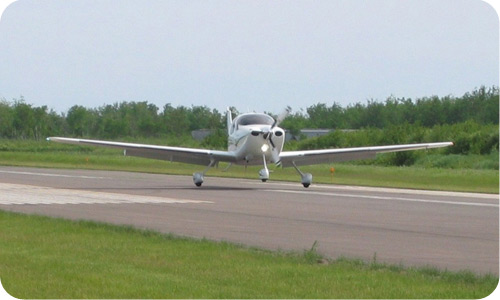
All information
pertains to both the CIRRUS SR22 and SR20, unless otherwise noted.
Follow the prescribed power setting, air speeds and
flap settings outlined in this Ground Segment to become more proficient
at executing safe landings during your Flight Segment. “Normal” Landings
This Ground Segment reviews procedures for
making a normal landing in a CIRRUS airplane. We define a “normal
landing” as one executed under VFR conditions, with the autopilot
off and no cross wind on the runway with a minimum length of 3,000'.
Note: Runways less than 3000' please refer
to the appropriate airplane POH for short field landing techniques.
Why do Landing Accidents Occur?
Click on the link below to learn
about landing accidents and how and when they can occur.
 Ups
and Downs of Takeoffs and Landings Ups
and Downs of Takeoffs and Landings
A Closer Look at a Landing Accident
Follow the
link below to review a landing accident from the NTSB website:
NTSB
Accident Brief
After you’ve reviewed the NTSB accident brief,
think about all the factors involved in this accident and how you
would have
prevented the accident.
- What affect did weather have?
- Was the runway
length or condition a factor?
- Did the pilot consider all risk
factors prior to attempting the landing?
- Can you identify any ‘red flags’ that
would have changed your decision to land under those conditions?
- What
in-flight decisions could have helped prevent this accident?
Stabilizing
Your CIRRUS for Safe Landings
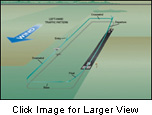
Safe landings depend on your skill at stabilizing your CIRRUS airplane
throughout each phase of the landing. Pay close attention to power
settings, airspeed, flap settings and airplane altitude and attitude
as you progress
through the traffic pattern to touchdown.
Enter the Traffic Pattern
- Enter the traffic pattern with your Before
Landing Checklist completed.
- Enter the traffic pattern at a 45°
angle to either the left or right downwind, based on the recommendation
for that runway.
- Enter the traffic pattern at 100 KIAS,
with approximately 15 inches of manifold pressure (approximately
20 inches for the CIRRUS SR20).
- Adjust your power to the recommended
settings and allow the airplane to slow to the desired airspeed
throughout the traffic pattern and landing phase, Avoid making
large and abrupt power adjustments because this will lead to an
unstabilized approach.
Note: You will vary power settings based on
air temperature, altitude,
and weight of the airplane. Make any small changes necessary
to maintain altitude
and airspeed
required for the traffic pattern entry.
Fly the Downwind Leg
- Enter the downwind leg at approximately
100 knots, with approximately 15 inches of manifold pressure
(approximately 20 inches of manifold pressure for the CIRRUS
SR20) and zero flaps.
- Abeam point (90° from
your runway touchdown point):
- Reduce
manifold pressure to Approximately 11 inches (12 inches
for the CIRRUS
SR20), and maintain airspeed at approximately 100 knots
- Set flaps
to 50%
- Ensure
your boost pump is on and mixture is full rich
- Begin
a 500' per minute descent (approx.)
- Re-trim
the airplane to adjust for the new power and flap configurations
- Fly downwind, continuing your
500-feet-per-minute descent, until you reach a
point on a 45° angle from your touchdown zone.
Fly the Base Leg
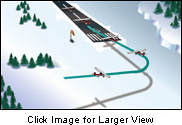
- At a 45° angle from your
touchdown point turn 90° to fly perpendicular
to the runway to begin your base leg.
- After completing
the turn set flaps to 100%.
- Airspeed should be gradually decreased
to 90 knots.
- Continue descending at 500' per
minute.
- Visually scan and stay aware of other
traffic.
Fly the Final Approach Leg
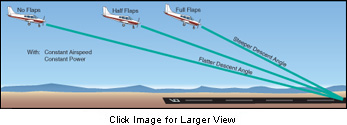
- Enter final approach when you determine that
you can turn from the base leg and roll out directly on the extended
runway centerline.
- Your airspeed should be gradually
decreased to 80 knots, with approximately 11 inches of manifold
pressure (75 knots of airspeed and approximately 12 inches of
manifold pressure for the CIRRUS SR20).
- Maintain flaps at 100%.
- Make small changes in power as necessary
to adjust airspeed,
- Make small changes in pitch to adjust the
airplane’s
descent rate to the intended touchdown point
- Make small
changes in bank to maintain runway centerline alignment.
- At most airports, you will fly a
3° glide path to the ground. Use the airport’s
Precision Approach Path Indicator (PAPI) or Visual Approach Slop
Indicator (VASI) to check the angle of your glide path.
- Stabilize the airplane for landing
by the time you reach 200' AGL. If your air speed,
manifold pressure, flaps, centerline tracking and/or glide path
are not
stabilized when you reach 200' AGL, execute a go-around.
- When you reach approximately 50' AGL,
begin to further slow the airplane by gradually decreasing
power
- Do not chop power. Slowly bring
power back. At the same time, begin to add
back pressure gradually in order to increase the airplane’s
pitch attitude.This will slow the airplane’s rate of descent
and also bleed off the airplane’s airspeed for a safe touchdown
on the main landing gear.
Roundout (Flare)
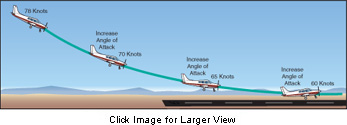
- Maintain flaps at 100%
(Important
note: the latest POH revision for the CIRRUS SR22
and SR20 calls for 100% flaps for all landings, including crosswind
landings.
There are no adverse effects to landing with 100% flaps in accordance
with the POH).
- As you begin the roundout (flare)
Approximately 10' to 20' AGL power should be reduced to the
idle position.
- Ensure that you have reduced speed
to approximately 65 knots at the point of touchdown.
- In order to allow the airplane to
settle onto the runway on the main gear first, use back pressure
to round-out or flare from a nose-low attitude to a nose-high
attitude of about 7-1/2° Round-out as you reach your
runway aiming point.
- If the airplane is not stabilized
at 20' AGL, execute a go-around.
Note: Do not reference the PFD for airspeed and pitch attitude while
in the roundout/flare and touchdown segment. Use outside visual
reference for pitch attitude and airspeed.


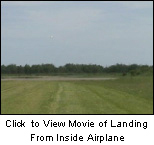 Touchdown
- With the power setting at idle,
an airspeed of approximately 65 knots and a nose-up attitude,
allow the airplane to settle onto the runway. Touch down on the
main wheels first, continuing the nose-up attitude.
- Avoid touching down on all three
wheels at the same time. Landing on the main gear is important
because it gives your airplane much more directional stability
when you transition from flying the airplane to driving it.
- Touching down on the nose wheel
first, or on all three wheels at the same time will make the
airplane difficult to control on the ground.
- After touchdown, use the rudder
only to steer and stabilize the airplane on the runway centerline
until you reach an airspeed where the rudder is no longer effective.
At the airspeed where the rudder is no longer effective use differential
braking to maintain directional control.
- If you are off the centerline, gently
maneuver the airplane back onto the centerline prior to touching
the brakes. Apply equal brake pressure to slow the airplane on
the runway.
Ever hear that a CIRRUS Lands Flat? Check out
the attitude and profile below:

A CIRRUS Lands like every other tricylce airplane. Check out:
- Attitude
- Angle of Attack
- Profiles
REMEMBER YOUR TRAINING
On Final Approach:
- 80 knots and stable
- Touch down on 2 wheels
- Hold stick back after touchdown
|
Avoid Common Landing Errors
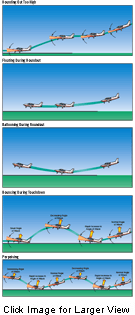
- Common landing errors include improper
power settings, excess airspeed, improper pitch angle and too-rapid
a rate of descent. These in turn can result in ballooning, bouncing
or porpoising. If you experience any of these three conditions,
the safest option is to execute a go-around.
- Ballooning can occur because of the following reasons:
- Carrying too
much airspeed into the roundout/flare.
- Adding excessive
pitch during the roundout and flare while still in ground
effect.
- Excessive pitch changes after ballooning
can lead to Pilot Induced Oscillations (PIO) or “porpoising.”
- A bounce can also result from chopping
power at 50' AGL, rather than bleeding power gradually to
idle at 10' AGL. Chopping power can result in an increase
in the airplane sink rate and a “firm touchdown” on
the runway, which can lead to a bounced landing.
- Landing too fast can also result
in a bounce. Airplane pitch will be too low and the airplane
will touch down very flat, landing on the nose wheel and main
gear at the same time, or even on the nose gear first.
When to Execute a Go-Around
Execute a go-around at any time the airplane
is not stabilized at 200' AGL or less. If you encounter ballooning
bouncing or porpoising, or if you observe obstacles on the runway
then execute a go-around.
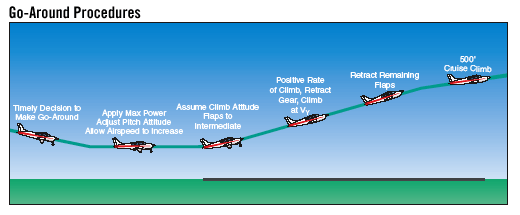
How to Execute a Go-Around
- Stop the descent rate of your airplane
and begin a controlled climb away from the ground by applying full
power, and maintain airspeed above 75-80 KIAS (81-83 KIAS SR20).
- Retract flaps from 100% to 50% after
the descent has stopped. Gradually increase the airplane’s
pitch to a climb attitude for VY.
- When you have gained a positive rate
of climb, cleared any obstacles and have reached a minimum airspeed
of 80 knots (85 KIAS SR20), retract flaps from 50% to zero and
continue a normal climb out. Re-enter the traffic pattern and re-initiate
the stabilization steps for landing described above.
Important
note: When applying full power to the CIRRUS, the airplane
will tend to roll and yaw to the left. Counteract this tendency by applying
the
appropriate amount of pressure to the right rudder.
|
|



|












